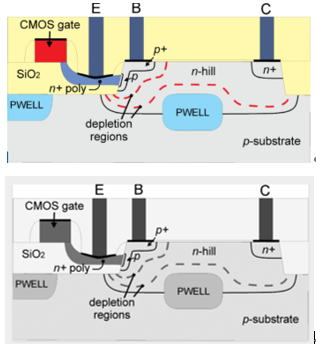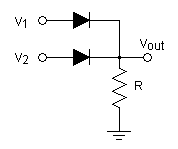 题目内容
(请给出正确答案)
题目内容
(请给出正确答案)
Which is basic logic gate?
A.NAND GATE
B.NOR GATE
C.OR GATE
D.XOR GATE
 参考答案
参考答案
 简答题官方参考答案
(由简答题聘请的专业题库老师提供的解答)
简答题官方参考答案
(由简答题聘请的专业题库老师提供的解答)
 网友提供的答案
网友提供的答案
- · 有3位网友选择 A,占比30%
- · 有3位网友选择 C,占比30%
- · 有2位网友选择 E,占比20%
- · 有1位网友选择 D,占比10%
- · 有1位网友选择 B,占比10%
 题目内容
(请给出正确答案)
题目内容
(请给出正确答案)
A.NAND GATE
B.NOR GATE
C.OR GATE
D.XOR GATE
 参考答案
参考答案
 简答题官方参考答案
(由简答题聘请的专业题库老师提供的解答)
简答题官方参考答案
(由简答题聘请的专业题库老师提供的解答)
 网友提供的答案
网友提供的答案
 更多“Which is basic logic gate?”相关的问题
更多“Which is basic logic gate?”相关的问题
 }?
}?
A、 can be interpreted as the difference of a martingale process.
can be interpreted as the difference of a martingale process.
B、E( ) = 0 for all t.
) = 0 for all t.
C、E( |
| ) = 0.
) = 0.
D、None of the above.
(2) 3D Heterogeneous Integration Every logic generation needs to add new functions in each node to keep unit price constant (to preserve margins). This is getting more difficult due to the following challenges: • Little functions left on board/system to co-integrate • Heterogeneous cores specialized per function—specialized performance improvement requirements needed per each dedicated core • Off-package memories—costly to co-integrate with logic, technology not fitting to baseline CMOS (where wafer/die-level stacking might be needed) Die cost reduction has been enabled so far by concurrent scaling of poly pitch, metal pitch, and cell height scaling. This would like to continue until 2024. Cell height scaling would likely to be pursued by 3D device (e.g., finFET and lateral GAA), device stacking, 3DVLSI, and design-technology-co-optimization (DTCO) constructs in cell and physical design. However, this scaling route will become challenged by diminishing electrical/system benefits and also by diminishing areareduction/$ at SoC level. Therefore, it is necessary to pursue 3D integration routes such as device-over-device stacking and/or monolithic 3D (or sequential integration) These pursuits will maintain system performance and power gains while maintaining the cost advantages such as treating expensive non-scaled components somewhere else and using the best technology fit per tier functionality. 3DVLSI offers the possibility to stack devices enabling high-density contacts at the device level (up to 100 million vias per mm² with N14 ground rules). 3DVLSI can be routed either at gate or transistor levels. The partitioning at the gate level allows IC performance gain due to wire length reduction while partitioning at the transistor level by stacking nFET over pFET (or the opposite), enabling the independent optimization of both types of transistors (customized implementation of channel material/substrate orientation/channel and raised source/drain strain, etc.) while enabling reduced process complexity compared to a planar co-integration, for instance the stacking of III-V nFETs above SiGe pFETs. These high mobility transistors are well suited for 3DVLSI because their process temperatures are intrinsically low. 3DVLSI, with its high contact density, can also enable applications requiring heterogeneous co-integration with high-density 3D vias, such as NEMS with CMOS for gas sensing or highly miniaturized imagers. In order to address the transition from 2D to 3DVLSI, the following generations are projected in the IRDS roadmap: • Die-to-wafer and wafer-to-wafer stacking o Approach: Fine-pitch di-electric/hybrid bonding and/or flip-chip assembly o Opportunities: Reducing bill-of-materials on the system, heterogenous integration o Challenges: Design/architecture partitioning • N&P stacking o Approach: Sequential integration o Opportunities: Reducing 2D footprint of standard cell o Challenges: Minimizing interconnect overhead is key between N&P enabling low-cost • Adding logic 3D SRAM and/or MRAM stack (embedded/stacked) o Approach: Sequential integration and/or wafer transfer o Opportunities: 2D area gain, better connection between logic and memory enabling system latency gains. o Challenges: Solving the thermal budget of interconnect at the lower tier if stacking approach is used, Revisiting the cache hierarchy and application requirements, power, and clock distribution • Adding Analog and I/O o Approach: Sequential integration and/or wafer transfer o Opportunities: Giving more freedom to designer and allows integration of high-mobility channels, pushing non-scaling components to another tier, IP re-use, scalability, IO voltage enablement in advanced nodes o Challenges: Thermal budget, reliability requirements, power and clock distribution • True-3D VLSI: Clustered functional stacks, beyond CMOS adoption o Approach: Sequential integration and/or wafer transfer o Opportunities: Complementary functions other than CMOS replacement such as neuromorphic, highbandwidth memory. Application examples include image recognition in neuromorphic fabric and wideIO sensor interfacing (e.g., DNA sequencing, molecular analysis). o Challenges: Architecting the application where low energy at low frequency and highly-parallel interfaces could be utilized, mapping applications to non-Von Neumann architectures. 1) Which of the following may not be the challenge to add new functions in each node of logic generation? ( ) A Little functions left on board/system to co-integrate B Heterogeneous cores specialized per function—specialized performance improvement requirements needed per each dedicated core C Technology not fitting to baseline CMOS D SRAM and FLASH memories 2) Which of the following may not reduce the die cost? ( ) A Scaling of pecialized performance B Scaling of poly pitch C Scaling of metal pitch D Scaling cell height 3) Cell height scaling would likely to be pursued by ( ) A 3D device B Device stacking C 3DVLSI D all of the above 4) 3D integration routes may not include ( ) A device-over-device stacking B scaling of poly pitch C sequential integration D monolithic 3D 5) We can maintain the cost advantages by ( ) for 3D integration. A using new materials for channel B using high κ dielectrics for gate C treating expensive non-scaled components somewhere else D Moore’s Law 6) According to the author, which of the following is false? ( ) A 3DVLSI may achieve high-density contacts at the device level. B 3DVLSI can be routed either at gate or transistor levels. C 3DVLSI allows IC performance gain due to wire length reduction D 3DVLSI may enable the optimization of one type of transistors. 7) What is the challenge for monolithic 3D integration? ( ) A Design of the system B Architecture C Minimizing interconnect overhead D Applications requiring heterogeneous co-integration with high-density 3D vias 8) What is the advantage of the N&P stacking? A Reducing bill-of-materials on the system B Reducing 2D footprint of standard cell C Reducing the thermal budget of interconnect D All of the above 9) According to the author, which of the following can achieve the 2D area gain? ( ) A Logic 3D SRAM and/or MRAM stack B Scaling of poly pitch C Scaling of metal pitch D All of the above 10) The author implies that neuromorphic may ( ) A be realized by wafer transfer. B be realized by CMOS solution. C be used in Von Neumann architectures. D be a highbandwidth memory.
A、generalization
B、classification
C、horizontal analysis
D、comprehensive analysis
完形填空 Bipolar transistors which have a fully depleted intrinsic collector can be used as high-voltage (HV) devices since they have increased values of breakdown voltages [1]–[2][3][4][5][6][7]. Furthermore, a base width modulation in such structures is suppressed allowing for aggressive scaling of the base layer, which results in a great tradeoff between common-emitter current gain (β) and early voltage (VA) , offering a good analog performance. A high-frequency performance is degraded, but devices working at the Jonhson’s limit are demonstrated [6]. The integration of a horizontal current bipolar transistor (HCBT) with standard 0.18-μmCMOS has been reported in [8] and [9]. A HV double-emitter (DE) HCBT is added to the process at zero additional costs [6]. In the DE HCBT, the intrinsic collector is fully depleted in the normal operation mode and transistors with BVCEO = 12.6 V, are demonstrated. Full depletion of the collector region is obtained by geometrical confinement of the intrinsic collector space charge by using the DE geometry. Recently, a DE HCBT with the reduced-surface-field (RESURF) region was reported with the BVCEOas high as 36 V [7]. It uses the CMOS p-well implant for the formation of local substrate which creates the additional RESURF drift region and improves the BVCEO. In the HCBT BiCMOS technology, a structure with the fully depleted collector can be obtained with single-emitter (SE) geometry as well. This can be accomplished by placing the CMOS p-well region under the n -collector near the intrinsic transistor. When the transistor operates in the normal operation mode, the intrinsic collector charge is shared and the collector is fully depleted. This paper presents a novel HV SE HCBT, which is integrated with the HCBT BiCMOS without additional cost. The structure achieves BVCEO= 10.5 V and fT=15.8 GHz. The electrical performance is comparable to the DE HCBT with medium BVCEO suitable for power amplifier applications. The main advantage over the DE HCBT is the scalability of the emitter length, which offers more flexibility in the physical design of circuits and better area efficiency. All three HV HCBT structures as well as high-speed (HS) HCBT are integrated in the same process flow which uses the steep collector profile reported in [10]. Cross section of the (1) is shown in Fig. 1. The structure is similar to the reported single polysilicon region HCBT [9]. The only difference is that the CMOS p-well region is implanted (2) the certain distance (3) the intrinsic base (4) the collector n -hill region. Standard HCBT process is described in [8] and [9]. Transistors are fabricated in the silicon islands defined by the shallow trench isolation process using a CMOS activemask. HCBT collector marked as (5) in Fig. 1 is implanted using an n-hill mask with the same implantation parameters as in [10]. An oxide etching mask is used for the formation of an emitter trench and it defines the (6) of the emitter (lE) , which extends out of the plane in the cross section of Fig. 1. The CMOS p-well implant is also used for the isolation of HCBT devices (7) a channel stopper shown in Fig. 1. Base and n+ collector masks are used for the intrinsic/extrinsic bases and the n+ collector implantations, respectively. The CMOS (8) next to the emitter trench (Fig. 1) is electrically inactive and is used to improve reliability of the emitter polysilicon processing [9].
Cross section of the (1) is shown in Fig. 1. The structure is similar to the reported single polysilicon region HCBT [9]. The only difference is that the CMOS p-well region is implanted (2) the certain distance (3) the intrinsic base (4) the collector n -hill region. Standard HCBT process is described in [8] and [9]. Transistors are fabricated in the silicon islands defined by the shallow trench isolation process using a CMOS activemask. HCBT collector marked as (5) in Fig. 1 is implanted using an n-hill mask with the same implantation parameters as in [10]. An oxide etching mask is used for the formation of an emitter trench and it defines the (6) of the emitter (lE) , which extends out of the plane in the cross section of Fig. 1. The CMOS p-well implant is also used for the isolation of HCBT devices (7) a channel stopper shown in Fig. 1. Base and n+ collector masks are used for the intrinsic/extrinsic bases and the n+ collector implantations, respectively. The CMOS (8) next to the emitter trench (Fig. 1) is electrically inactive and is used to improve reliability of the emitter polysilicon processing [9].

A、positive logic OR gate
B、positive logic AND gate
C、negative logic OR gate
D、negative logic AND gate
A、Demodulation
B、Modulation
C、
D、

 警告:系统检测到您的账号存在安全风险
警告:系统检测到您的账号存在安全风险
为了保护您的账号安全,请在“简答题”公众号进行验证,点击“官网服务”-“账号验证”后输入验证码“”完成验证,验证成功后方可继续查看答案!
